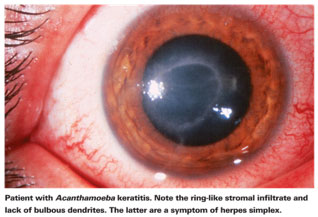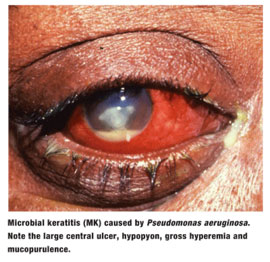
This author has put together the "fearsome five" i.e., the worst five afflictions based on my rankings. Here are the first two.
Number One: Acanthamoeba
The near invincible Acanthamoeba tops off the list as the infamous number one. Like Pseudomonas, Acanthameoba is a microorganism that is ubiquitous. It is found in soil, water, and many other everyday locales. Infection is rare, similar to Pseudomonas, but when infection does occur its extremely dangerous and devastating. And, thanks to some high profile cases involving corporate quality control negligence it edges out Pseudomonas in the list. It is a true free living monster that can infiltrate and lay waste to a victims cornea.
Transmission
- Acanthameoba is a very tough organism to kill as it can transform itself into a cyst. While in this dormant defensive form it becomes resistant to temperature changes, pH changes, and resistant to immune system attacks.
- The transmission vehicle is identical to Pseudomonas. Contact lens wearers are the main target for ocular Acanthameoba infection. People with recent agricultural inflicted eye trauma would be the second most common victims.
- A person that decides to create his or her own saline solution for contacts runs a risk of Acanthameoba infection. Since Acanthameoba is found naturally in water, if the saline solution isn't fully sterilized Acanthameoba can thrive.
- A person that doesn't follow cleaning protocol in regard their contact lens case is also at risk of allowing Acanthameoba to growing inside the case.
- Contaminated commercial contact lens solution can also cause Acanthameoba infection. In 2006 Bausch & Lomb recalled its contact lens solution due to Acanthameoba contamination. Also a 2007 recall occurred for the same reason by the AMO corporation.

Symptoms
- Initial symptoms appear as epithelial irregularities and ring-shaped infiltrates which mimic other much more common ocular problems. This makes it difficult to diagnose.
- A clue to Acanthameoba presence is an extraordinary amount of pain in what appears to be a minor low pain corneal problem.
- Exquisitely high photophobia is another symptom. People often come to their exam with two pairs of sunglasses on and a jacket pulled over their head to block out light.
- Super-infection with bacteria is common making treatment and diagnosis even more difficult.
- Damage to the cornea is severe leading to total vision loss and/or corneal transplant.
Treatments
- There are no FDA-approved medications for treating Acanthameoba infection.
- Aggressive surgical and antimicrobial treatments need to occur immediately. Even then the treatments last from three months to over a year with grim outcomes. Many patients still end up requiring corneal transplants.
- Treatment with high levels of steroids is common however it often then leads to superinfection with bacteria further complicating the problem.
- When Acanthameoba forms a cyst it is nearly impossible to kill.
Contagious
- Like Pseudomonas, Acanthameoba is not directly contagious.
- Sharing contaminated products like solution and/or cases can spread the infection.
Ranking
- Acanthameoba is number one in the fearsome five. It ranks high due to its extreme pain, damage, and photophobia. It also is nearly impossible to treat and requires immediate aggressive surgeries. Even so, the aggressive treatments continue for up-to over a year with grim outcomes, often resulting in corneal destruction and transplants. Acanthameoba ranks high for its extreme toughness. However, it ranks low in the contagious area as it is usually limited to contaminated contact lens solution and cases or agricultural caused eye injuries. It edges out Pseudomonas in this area due to the high profile contaminated product recalls.
Number Two: Pseudomonas
The terrifying infection by Pseudomonas (aka The Cornea Melter) is number two on the fearsome five list. And for good reason. Pseudomonas is an ubiquitous bacteria that is commonly found in soil, water and plants. Normally Pseudomonas is harmless to humans however in certain situation an extremely dangerous and nightmarish infection can occur. To add to the risk factor, all non-disposable contact lens wearers are at the most risk of a Pseudomonas infection.
Transmission
- Pseudomonas is ubiquitous and you probably have a few of the bacteria on you as you read this. However, the danger occurs when it forms a colony in the solution or case of contact lens wearer.
- A person that decides to create their own saline solution for contacts runs at risk of Pseudomonas infection since Pseudomonas is found naturally in water. Also if the saline solution isn't fully sterilized Pseudomonas can thrive.
- A person that doesn't follow cleaning protocol in regards to their contact lens case is also at risk of allowing Pseudomonas to grow inside the case.

Symptoms
- Pseudomonas infection to the eyes are devastating. Often resulting in a melted cornea. Thus the moniker "The Cornea Melter".
- The infection is extremely painful due to nerve exposure associated with the melting of the epithelial and stromal cell layers.
- The wound is also susceptible to secondary superinfection.
- If the Pseudomonas infection is not treated properly, and even in some cases of quick medical intervention, the victims infected eye has to be removed (enucleated).
- If the infection is successfully stopped, often-severe vision loss occurs. Severe being equating to NLP, or 5/200 VA.
Treatments
- There are no vaccines for Pseudomonas and it is notoriously resistant to antibiotics.
- Even if diagnosed and treated on day 1 of the infection, outcomes are grim resulting in blindness or enucleation.
- With such a narrow window of treatment finding an effective antibiotic is very challenging.
- Most often the only successful method is removing the infected tissue.
Contagious
- Since Pseudomonas is usually harmless it is not very contagious.
- The transmission vehicle is dirty contact lens solution and cases. So avoiding and disposing of them will eliminate any cross contamination.
Ranking
- Pseudomonas is a close number two. It ranks high because it is extremely painful, and has horrifying corneal melting symptoms. It also ranks high due to its grim outcomes even after immediate treatment. Often resulting in loss of an eye or total blindness. It is not very easy to contract except for non-compliant contact lens wearers and is uncommon so it scores low in that area.













